Excavation backfilling best practices are key for keeping construction and infrastructure projects safe. PAR’s Services Ltd knows how tough underground work can be. They make sure safety is top priority at every excavation project stage.
OSHA says excavation is any cut, cavity, trench, or depression in the Earth’s surface made by removing earth. So, experts must be very careful and follow strict safety rules for each project.
Excavation backfilling needs special knowledge, precise skills, and a strong focus on protecting workers. Safety procedures are not just suggestions—they are vital for avoiding accidents and making projects successful.
Key Takeaways
- Always conduct thorough site assessments before excavation
- Implement protective systems for trenches over 1.2 metres deep
- Classify soil types accurately for excavation needs
- Use proper personal protective equipment always
- Keep constant communication and monitoring during work
- Follow local laws for excavation safety
Understanding Excavation Safety Fundamentals
Excavation work needs strict safety rules and a deep understanding of industry standards. Following construction specifications is key to protecting workers and ensuring project success. Professionals must deal with complex rules while keeping safety at the highest level.
Excavation projects have many safety issues that contractors must handle carefully. The skills of contractors greatly affect their ability to keep workers safe and follow strict rules.
Regulatory Compliance and Standards
OSHA’s excavation rules, found in Title 29 Part 1926 Subpart P, offer detailed safety guidelines. Important rules include:
- Daily site checks by skilled people
- Using the right protective systems
- Protecting underground utilities
- Testing the air before starting work
Key Terminology in Excavation Work
Knowing technical terms is vital for clear communication and safety. Important excavation words help teams work together well and avoid safety risks.
- Competent Person: Someone authorized to spot dangers
- Trench: A narrow hole dug below ground
- Protective System: A way to stop cave-ins
Role of Competent Person Supervision
A competent person is essential for keeping excavation sites safe. Their tasks include:
- Doing daily safety checks
- Finding and fixing dangers
- Setting up safety measures
- Following the rules
Safety is not an option—it’s a necessity in excavation work.
Pre-Excavation Planning and Site Assessment
Starting a successful excavation project needs careful planning before digging begins. Good project management is key to avoiding risks and keeping workers safe. A detailed site assessment is a must, with several important steps to follow.
The first step in planning is to document and check everything. This includes:
- Getting detailed alignment sheets
- Checking underground utility marks
- Inspecting equipment thoroughly
- Looking at environmental impacts
Today, thinking about the environment is very important in excavation. Experts must look at how digging might affect nature. They check the soil, water below, and if they might harm animals or plants.
Getting ready technically is also vital. This means:
- Doing detailed site surveys
- Mapping underground utilities
- Writing down risk assessments
- Creating safety plans
Good planning before digging can cut risks by up to 60% and stop accidents.
It’s also important to understand the ground. Knowing the ground helps teams plan for problems and find solutions. They look at soil strength, water levels, and how much weight the ground can hold.
Essential Safety Equipment and PPE Requirements
Excavation work needs strict safety rules to keep workers safe. The skills of contractors are key to a safe place to work. Knowing and using the right safety gear can greatly lower risks at work.
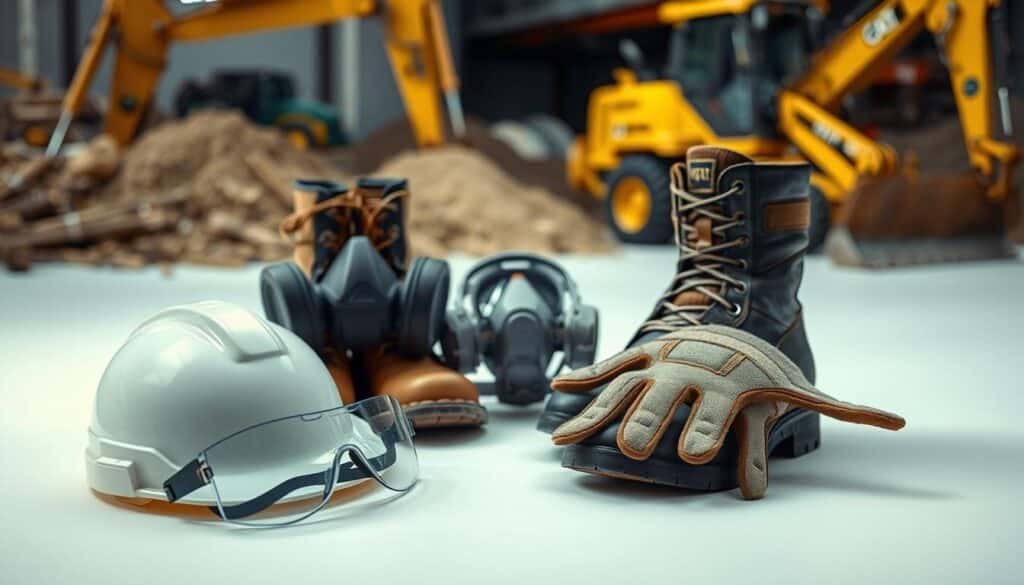
Good safety management means using the right PPE and being ready for emergencies. Here’s a list of important safety items for digging work:
- Hard hats with chin straps
- High-visibility safety vests
- Steel-toed protective boots
- Safety glasses or face shields
- Hearing protection devices
- Respiratory protection equipment
- Fall protection harnesses
Equipment Inspection Protocols
Checking equipment regularly is key for safety. Contractors should carefully check all safety gear and tools before starting work.
| Equipment Type | Inspection Frequency | Key Check Points |
|---|---|---|
| Personal Protective Equipment | Daily | No tears, proper fit, no structural damage |
| Safety Harnesses | Before each use | Webbing integrity, buckle function, attachment points |
| Protective Footwear | Weekly | Steel toe cap condition, sole attachment |
Emergency Response Tools
Contractors need to know how to use emergency tools. Important tools for digging sites include:
- First aid kits
- Fire extinguishers
- Communication devices
- Emergency rescue equipment
- Oxygen tanks
Note: Proper training and regular maintenance of safety equipment are key to avoiding accidents at work.
Soil Classification and Analysis Methods
Knowing about soil is key for good excavation and backfilling. It helps engineers pick the right backfilling methods and testing.
Soil types are sorted by several important traits:
- Particle size and distribution
- Moisture content
- Compaction ability
- Drainage skills
The AASHTO classification system breaks soils into 15 groups. It gives a detailed way to analyze them. This helps experts decide if soil is right for digging and filling projects.
| Soil Type | Particle Size | Compaction Characteristics |
|---|---|---|
| Cohesive (Clay) | 0.00004″ to 0.002″ | Needs a lot of force to compact |
| Silt | 0.0002″ to 0.003″ | Needs moderate force to compact |
| Sand | 0.003″ to 0.08″ | Compacts well with vibration |
| Gravel | 0.08″ to 1.0″ | Has great drainage |
Quality control testing is vital for good excavation and backfilling. Important tests include:
- Sieve Analysis
- Proctor Compaction Test
- Moisture Content Analysis
- Soil Density Evaluation
Construction teams must check soil carefully to avoid problems later. By knowing about soil and using detailed tests, they can build strong foundations.
Excavation Backfilling Best Practices
Excavation backfilling needs precision, skill, and a focus on details. It involves picking the right materials, using the best compaction methods, and checking quality closely. This ensures the structure stays strong over time.
Choosing the right backfill material is key at the start. Not every material fits every project. The right choice can make a big difference in how stable and long-lasting the structure is.
Material Selection Guidelines
When picking backfill materials, think about these important points:
- Soil type and how it drains
- What the project needs
- The environment it’s in
- How much weight it can hold
Good backfill materials include:
- Sandy soil – drains well
- Clay soil – compacts well
- Loamy soil – has a good mix
Compaction Techniques
Compacting soil is key to a solid base. Using machines helps make the soil denser and less likely to settle.
- Vibratory rollers
- Plate compactors
- Tamping rammers
- Water jetting for sandy soils
Quality Control Measures
Good quality control makes sure the backfill meets standards:
- Do compaction tests every 2-3 feet
- Keep the soil moist (10-15%)
- Check the layer thickness (6-12 inches per layer)
- Try to get at least 95% compaction
By sticking to these best practices, builders can lower risks and build a strong foundation for their projects.
Underground Utility Protection Measures
Keeping underground utilities safe is key in construction. The Canadian Common Ground Alliance (CCGA) has set up detailed rules to lower risks from digging.
Excavation teams must follow strict rules to protect important infrastructure. The main steps are:
- Do thorough utility surveys before starting work
- Reach out to local utility companies for exact underground maps
- Use the national 811 “Call Before You Dig” service
- Mark all found underground utilities with clear markers
Special tools help find and protect underground systems. Experts use ground-penetrating radar and electromagnetic locators for precise maps.
Keeping everyone safe means detailed records and teamwork. Contractors need to keep up-to-date records of underground utilities. They must also follow strict safety rules during digging.
| Utility Type | Detection Method | Protection Requirement |
|---|---|---|
| Electrical Lines | Electromagnetic Scanning | Minimum 2-foot Lateral Clearance |
| Water Pipes | Ground-Penetrating Radar | Protective Barriers |
| Gas Lines | Advanced Locator Technology | Certified Safety Markings |
The CCGA’s guidelines focus on managing risks ahead of time. Stopping underground utility damage needs careful planning, the latest tech, and strict safety rules.
Proper Trench Support Systems
Excavation backfilling best practices need careful attention to trench support systems. These systems are key to keeping workers safe from cave-ins. They also help keep the site stable during underground projects.
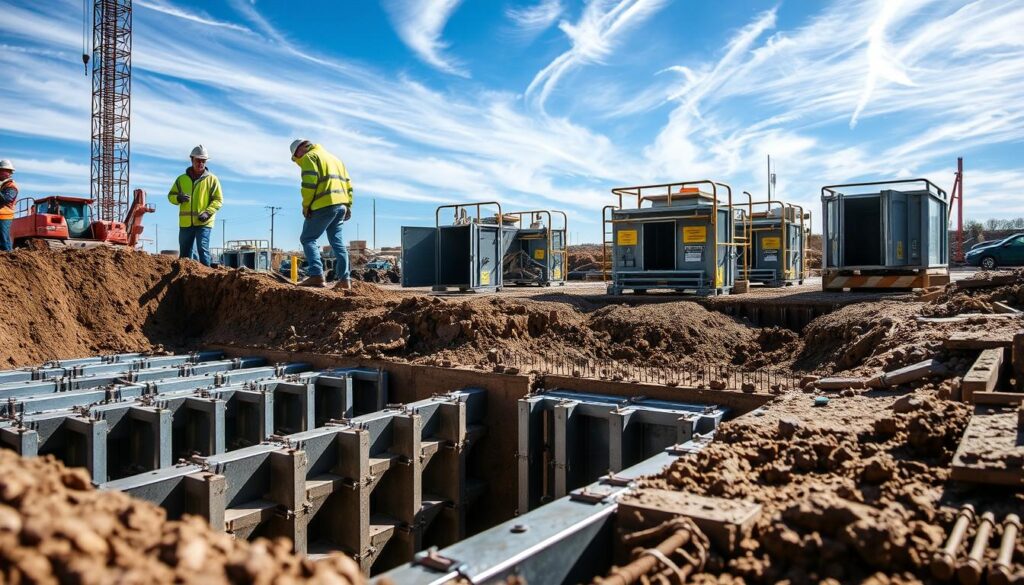
Effective trench support uses different methods to stop soil collapse. It’s important to know the specific needs of each excavation site. This knowledge helps in setting up the right safety procedures.
Shoring Methods for Excavation Protection
Trench shoring is vital for excavation work. It keeps the trench stable. There are many methods used:
- Timber shoring systems for traditional applications
- Hydraulic jack supports for dynamic work environments
- Steel sheet piling for challenging soil conditions
- Pneumatic shoring for specialized excavation projects
Benching and Sloping Requirements
Excavation safety depends on the ground’s shape. Here are some guidelines for stability:
| Soil Type | Slope Angle | Maximum Depth |
|---|---|---|
| Type 1 (Hardpan/Consolidated Clay) | 1:1 (45 degrees) | 4 feet |
| Type 2 (Silty Clay) | 1:1 (45 degrees) | 4 feet |
| Type 3 (Previously Excavated) | 1:1 | 3 feet |
| Type 4 (Sensitive Material) | 1:3 | 2 feet |
Support System Maintenance
Regular checks are key to keeping trench support systems working. Competent persons must verify safety conditions at important times:
- Beginning of each work shift
- After significant weather changes
- Following any structural modifications
- Immediately after detecting any instability
Remember, excavation backfilling best practices need constant watchfulness. Safety management must always be proactive to avoid accidents.
Water Management and Drainage Solutions
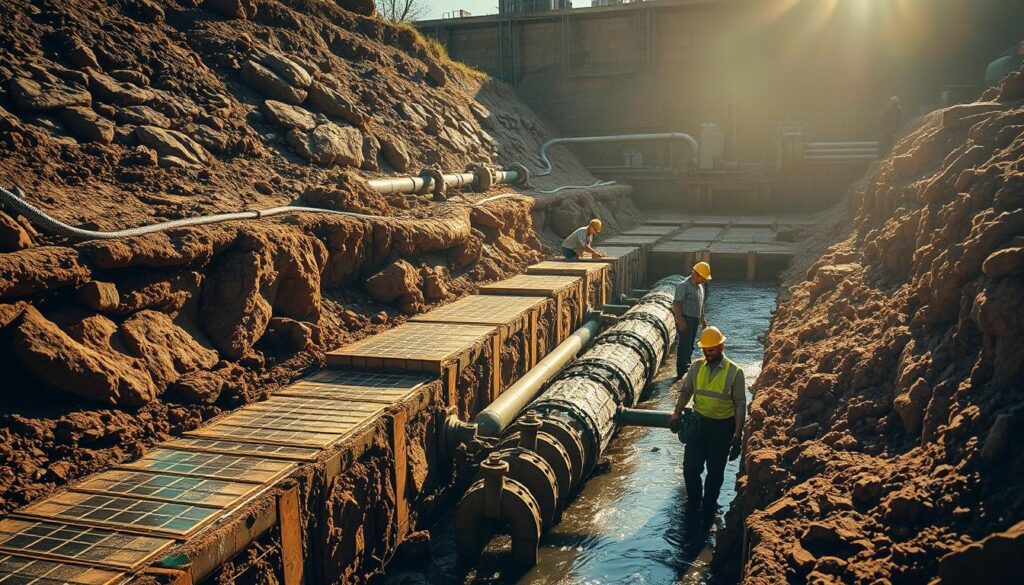
Effective water management is key in excavation projects. It keeps the site stable and stops water-related dangers. Using cost-effective methods can greatly lessen drainage problems and safeguard underground structures.
Water getting into the excavation can weaken it. Studies show up to 40% of construction sites face drainage issues because of poor management. To control water well, you need a plan that tackles both surface water and groundwater.
Key Water Management Strategies
- Install efficient dewatering systems
- Design proper drainage channels
- Create retention basins
- Implement erosion control measures
It’s important to think about the environment when managing water. Experts must find a balance between meeting site needs and protecting nature. They use green drainage solutions that harm the environment less.
| Water Management Technique | Effectiveness | Cost Efficiency |
|---|---|---|
| Well Point Systems | High | Moderate |
| Sump Pump Installations | Very High | Low |
| French Drain Systems | Moderate | High |
“Proper water management is not just about controlling water, but protecting your entire excavation ecosystem.” – Construction Safety Expert
Smart drainage solutions can cut down water risks by up to 50%. They protect underground structures and stop soil erosion. By using advanced water management, construction teams can succeed while caring for the environment.
Compaction Testing and Quality Assurance
Quality control testing is key to the success of excavation backfilling projects. It ensures the structure’s strength and stability over time. Soil compaction methods need careful checking to meet project needs and standards.
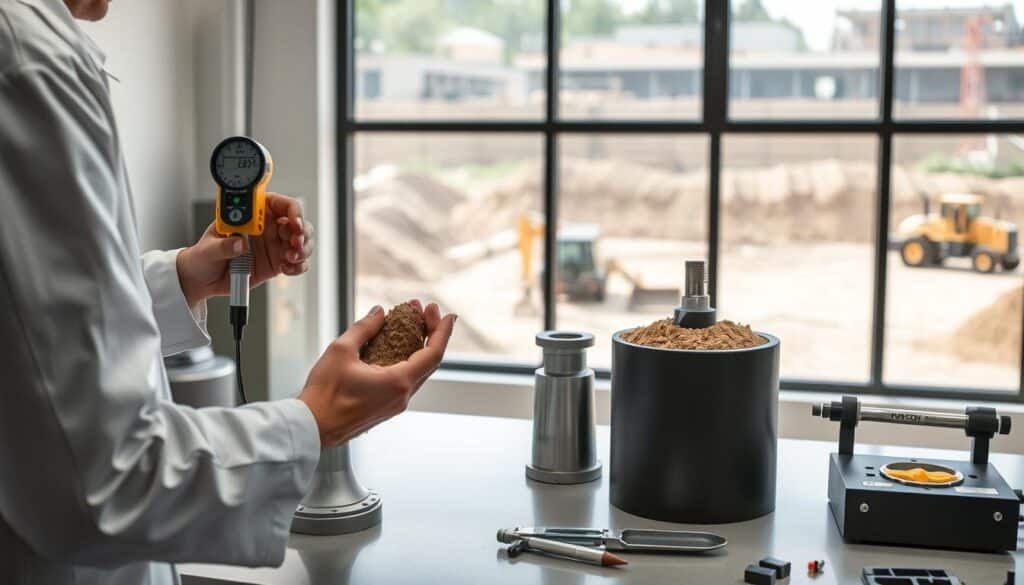
Quality control testing includes several important steps. These steps make sure backfilled excavations are reliable:
- Comprehensive density testing
- Moisture content verification
- Material performance evaluation
- Systematic documentation
Density Testing Methods
Construction experts use different ways to check soil compaction. Nuclear density gauges and sand cone tests are the top choices. They help find out the material’s density and any possible weaknesses.
| Testing Method | Accuracy | Application |
|---|---|---|
| Nuclear Density Gauge | High | Rapid on-site testing |
| Sand Cone Test | Precise | Detailed density measurement |
| Electrical Density Gauge | Moderate | Non-nuclear alternative |
Documentation Requirements
Keeping detailed records is vital in quality control testing. Experts must keep logs that include:
- Test location and date
- Compaction test results
- Material certifications
- Moisture content measurements
Acceptance Criteria
Backfill projects succeed when they meet certain compaction standards. Key acceptance parameters include density requirements, moisture content ranges, and material quality assessments.
Precision in soil compaction methods ensures structural durability and minimizes future settlement risks.
Environmental Impact Considerations
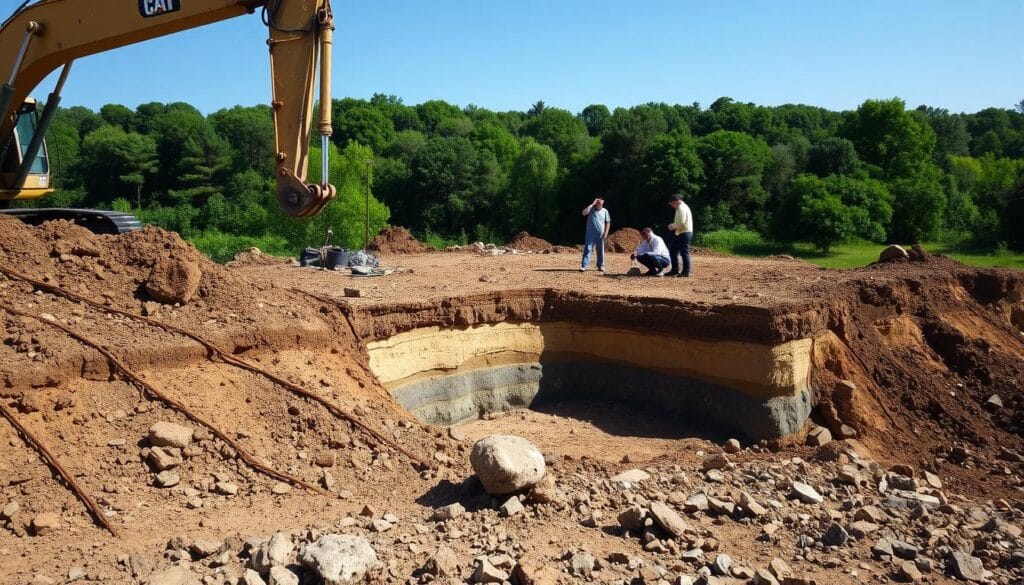
Excavation projects need careful planning to protect the environment. They must follow strict rules to avoid harming nature. Experts use smart methods to keep ecosystems safe and projects running smoothly.
“Sustainable excavation is not just a choice, but a responsibility to our environment and future generations.”
Important steps for green excavation include:
- Using precise techniques to disturb soil less
- Controlling dust with special methods
- Keeping local wildlife safe during work
- Handling waste in a responsible way
Good environmental management starts with a solid plan. Our studies show big chances to lessen harm to the environment with smart strategies.
| Environmental Metric | Improvement Percentage |
|---|---|
| Dust Generation Reduction | 65% |
| Fuel Consumption Efficiency | 50-60% |
| Site Disturbance Minimization | 55% |
Important steps for the environment include soil sampling protocols, waste management, and caring for nature. Construction teams must do detailed environmental checks. They use methods like:
- Testing soil quality fully
- Using eco-friendly protective materials
- Setting up systems to manage water well
- Sharing resources to cut down on transport needs
By focusing on the environment and following rules, excavation projects can greatly reduce their impact. They can do this while keeping their work top-notch.
Site Restoration and Clean-up Procedures
Effective project management is key in the final stages of excavation. Site restoration is the last step, ensuring a project’s finish and environmental care.
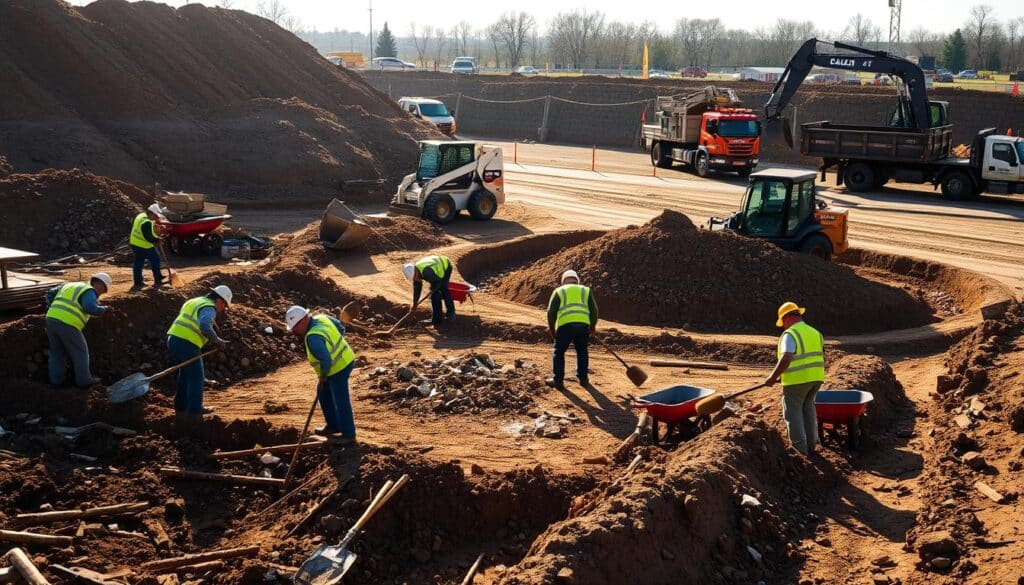
Restoring a site well involves many steps that need careful planning. It’s more than just cleaning up. It’s about making the site ready for its next use or returning it to its original state.
Surface Finishing Requirements
Cost-effective methods are important for surface restoration. Key points include:
- Precise grading for good drainage
- Replacing topsoil with the right material
- Leveling and smoothing the ground
- Removing construction waste and extra materials
Vegetation Restoration
Restoring vegetation needs careful planning. Important steps are:
- Picking native plants that fit the local area
- Using measures to stop erosion
- Preparing the soil for plants to grow well
- Creating a lasting green cover
Final Inspection Protocols
Final checks are vital for site restoration. Experts should look at:
- How even the surface is and if it drains well
- If plants are growing well
- If all construction stuff is gone
- If the site meets environmental rules
Good site restoration shows care for the environment and makes clients happy.
Safety Documentation and Record Keeping
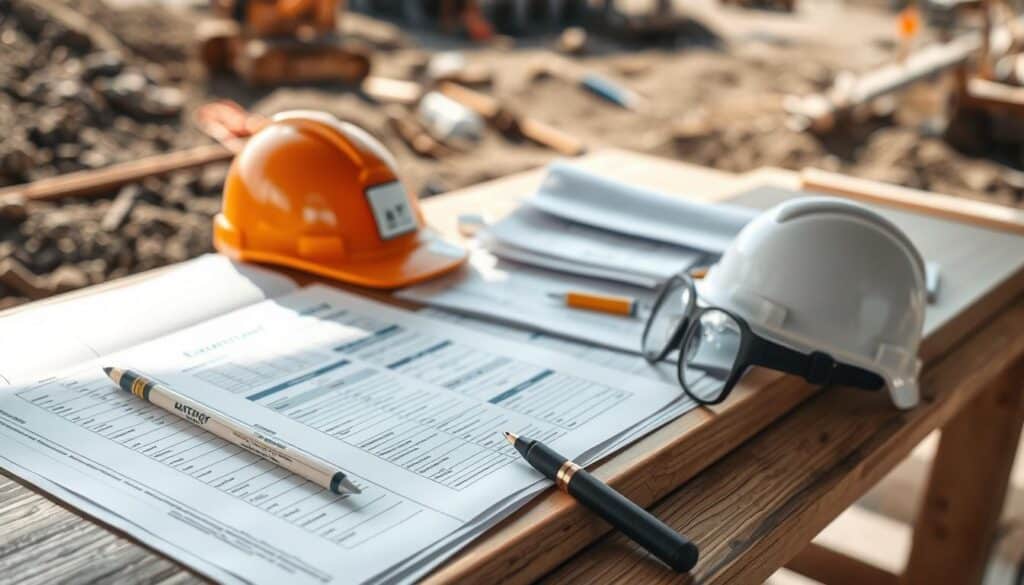
Keeping detailed site safety records is key for construction success. Good documentation is the heart of site safety and following construction rules. Excavation work needs careful record-keeping to keep workers safe and show they follow the law.
Important documentation practices include:
- Daily inspection reports detailing site conditions
- Incident logs tracking possible safety problems
- Equipment maintenance records
- Employee training documents
Digital solutions have changed how construction teams handle safety records. Electronic systems make tracking easier, information more accessible, and work more efficient. These tools help managers find important info fast during checks or reviews.
Important documents for excavation projects should cover:
- Notes from competent person inspections
- Risk assessment documents
- Worker training and certification
- Equipment check and maintenance logs
Companies must focus on building strong documentation systems. These systems should meet legal needs and improve site safety. Good record-keeping shows a commitment to worker safety and excellence in construction management.
Training Requirements and Certification
Contractor qualifications are key to keeping excavation and backfilling sites safe. Professional training programs help create skilled workers. These workers can handle complex construction sites safely.
Important training for excavation workers includes:
- Hazard recognition and risk assessment
- Proper use of protective equipment
- Underground utility identification techniques
- Emergency response protocols
Certification shows a worker’s skill in site safety. The National Construction Safety Team suggests different certification levels:
- Entry-Level Safety Certification – Basic knowledge of excavation basics
- Advanced Safety Specialist Certification – Deep understanding of complex excavation methods
- Safety Management Certification – Leadership and safety strategy development
In Canada, workers must finish safety training before starting excavation projects. These programs teach workers about essential safety rules. This helps lower accidents and builds a safety-focused work environment.
Safety education is not just a requirement—it’s an investment in protecting human lives and maintaining project integrity.
Conclusion
In Canada, construction needs strong project management. This includes safety, efficiency, and being green. Excavation and backfilling are key to building well.
Knowing about soil and using the right tools are important. New methods like geosynthetic materials help a lot. They make buildings strong and protect the environment.
PAR’s Services Ltd is all about top-notch excavation and backfilling. We handle tough projects and use the latest in drainage. Our team knows how to meet local needs and follow rules.
Need help with excavation and backfilling? Call PAR’s Services Ltd at +(604) 278-4445. We’re here to make your project a success.
